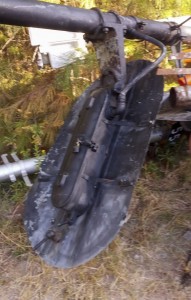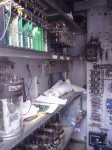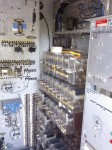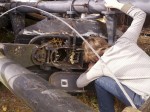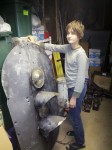 Getting the precious home was one thing. Getting it to work was the next. I wanted to see these things light up. While the internet is one of my favorite things, trying find the right words to search when stepping into a completely new subject can be tricky. This one fortunately came together rather quickly. These signals are called (wait for it…) “Colored Light Signals“. More, mine are “R2” 3 Light Colored Light Signals. Some places throw a ‘vertical’ in the title somewhere too. The details start to fall off quickly and get somewhat vague. While there are many people who collect train items, or “Railroadiana” as I have just learned, not many people write about it, or more to the point, restoring it. Don’t get me wrong, I found a few sites, but the real juicy details run a little thin. I decided that it was time to pull out the multimeter and figure out the wiring myself.
Getting the precious home was one thing. Getting it to work was the next. I wanted to see these things light up. While the internet is one of my favorite things, trying find the right words to search when stepping into a completely new subject can be tricky. This one fortunately came together rather quickly. These signals are called (wait for it…) “Colored Light Signals“. More, mine are “R2” 3 Light Colored Light Signals. Some places throw a ‘vertical’ in the title somewhere too. The details start to fall off quickly and get somewhat vague. While there are many people who collect train items, or “Railroadiana” as I have just learned, not many people write about it, or more to the point, restoring it. Don’t get me wrong, I found a few sites, but the real juicy details run a little thin. I decided that it was time to pull out the multimeter and figure out the wiring myself.
I got the first signal flipped around so I could get at it’s innards. The CSX guy had taken the lock off of this unit when I was talking to him, so there were no issues getting into it. When I opened it up, I found years, and years of bugs, dirt, and all sorts of other miscellaneous debris that had accumulated. They have a seal that appears to be a heavy cotton weave that was dipped in perhaps oil, or tar. But these seals have dried out long ago and started to fall apart, giving all sorts of creatures free access to come and go as they please. Lady bugs seem to be especially popular. I spent a few minuted with a brush and a vacuum getting it cleaned out.
 I am impressed with how tough they built these things to be. All the wiring is thick and heavy. All connections are double bolted to assure nothing would come apart. In the information I found, it looks like these run on 12 volts, but it’s a little odd, the bulbs are spec’d at 10v. There were only 4 wires and 3 lights, so this was going to be somewhat easy. For the un-electronically minded, in order to light a bulb, you need to make a circuit that spans from the voltage source, to what we call ground. If there is a break anywhere along the way, the electricity can not flow from point a to z. If you test a system like this, and all the bulbs are in good condition, it would seem as if all these wires were connected. And technically, they are. This is because a the light bulb filament is nothing more than a coiled wire with high resistance. The resistance causes this wire to heat up and glow. In order to sort out which wires go to which lights, and which one is ground, we need to break the circuit. The easy solution here is to remove the lightbulbs. Once the bulbs were out, I was able to identify the red, yellow, and green lights. The green is actually almost blue. I labeled, the wires with colored electrical tape for easy identification at a later point.
I am impressed with how tough they built these things to be. All the wiring is thick and heavy. All connections are double bolted to assure nothing would come apart. In the information I found, it looks like these run on 12 volts, but it’s a little odd, the bulbs are spec’d at 10v. There were only 4 wires and 3 lights, so this was going to be somewhat easy. For the un-electronically minded, in order to light a bulb, you need to make a circuit that spans from the voltage source, to what we call ground. If there is a break anywhere along the way, the electricity can not flow from point a to z. If you test a system like this, and all the bulbs are in good condition, it would seem as if all these wires were connected. And technically, they are. This is because a the light bulb filament is nothing more than a coiled wire with high resistance. The resistance causes this wire to heat up and glow. In order to sort out which wires go to which lights, and which one is ground, we need to break the circuit. The easy solution here is to remove the lightbulbs. Once the bulbs were out, I was able to identify the red, yellow, and green lights. The green is actually almost blue. I labeled, the wires with colored electrical tape for easy identification at a later point.
 It was time to test the signal. I have a fairly intense 12 volt power supply I picked up from the Hamfest last year. I put the bulbs back into their sockets. Being that ground is always ground, I alligator clipped ground to the power supply. Then I was able to go through each bulb. These signals have been through a lot of abuse as of late. They were removed from God knows where and tossed on some sort of vehicle. There were clearly dumped where we found them. Given the scars, and bends in the metal, they have been bashed a few times. All 3 bulbs lit without issue. Impressive. While I was in and amongst the lenses, I figured that they probably had not been washed… ever. I removed the lens retainer rims and pulled out each of the 8.5 inch lenses. I gave them a good scrub in some hot soapy water as the gunk that they were covered in just would not come off. After a bit of work, they started to sparkle. There was a residual black substance on the lenses that looked like spray paint overspray. I went after this with some acetone which took it right off.
It was time to test the signal. I have a fairly intense 12 volt power supply I picked up from the Hamfest last year. I put the bulbs back into their sockets. Being that ground is always ground, I alligator clipped ground to the power supply. Then I was able to go through each bulb. These signals have been through a lot of abuse as of late. They were removed from God knows where and tossed on some sort of vehicle. There were clearly dumped where we found them. Given the scars, and bends in the metal, they have been bashed a few times. All 3 bulbs lit without issue. Impressive. While I was in and amongst the lenses, I figured that they probably had not been washed… ever. I removed the lens retainer rims and pulled out each of the 8.5 inch lenses. I gave them a good scrub in some hot soapy water as the gunk that they were covered in just would not come off. After a bit of work, they started to sparkle. There was a residual black substance on the lenses that looked like spray paint overspray. I went after this with some acetone which took it right off.
I then worked on the shrouds. The shrouds were seriously banged up. I unscrewed these from the main body. Sadly some of the screws heads were snapped off in the rough handling. I still need to sort out how to back those out. But the rest were removed and replaced. The old ones were getting old and quite rusty. I was able to sort out the screw type with the sweet little screw board they have at our local ACE. They are 10-32 in case you are looking for sizes (or placed here in case I forget). Once they were off, I used a flat headed hammer and started the somewhat lengthy process of banging these things back into shape. After a while, these things started to look quite proper. I screwed them back onto the signal and lit the whole thing up. Alive… IT’S ALIVE!!! Muahh ahh ahhhh.
 Getting into the second signal was not as easy. Being that this was a ‘late offering’, it came intact and with a lock. It was clear that this lock meant business, and it was not going to be bypassed with a simple wire cutter. More, I did not want to break the thing as it was pretty cool. It was time to dust off my lock picks and see if I could get in. The lock was pretty rusty, so I drenched it with WD-40 and let it sit for a while. After some time, I gave it a go. It became clear somewhat quickly that this needed a lot of tension. There were wafers on both top and bottom which was a little challenging as I had to off set the tension so I could get at both sides.
Getting into the second signal was not as easy. Being that this was a ‘late offering’, it came intact and with a lock. It was clear that this lock meant business, and it was not going to be bypassed with a simple wire cutter. More, I did not want to break the thing as it was pretty cool. It was time to dust off my lock picks and see if I could get in. The lock was pretty rusty, so I drenched it with WD-40 and let it sit for a while. After some time, I gave it a go. It became clear somewhat quickly that this needed a lot of tension. There were wafers on both top and bottom which was a little challenging as I had to off set the tension so I could get at both sides.  Once I figured that out, I got the keyway to turn in no time. The keyway might have turned, but the shackle did not budge. Not even a little. This was somewhat puzzling. If the keyway turned, that thing should have popped. I started reading up on these locks. If it were a newer lock this would have been a feature of the lock, it would have gone into a failure mode if opened incorrectly, but this was not the case. The 3 digit code is a manufacturer code which states when the lock was made.. This lock was made in November of 1990. I started to really look at the whole lock. One thing that struck me is how much paint was on it. It looks like the signs would get an occasional coating of paint. The coating is not handled with care, nor precision, rather it is just sort of slathered on and whatever gets hit, gets hit, and it just gets caked on. I started wondering if the lock had gotten paint inside of the shackle casing. Feeling a little silly, and knowing that there was no way that I would be able to hurt the signal, nor the lock, I re-picked the lock. Once I got it to turn, I placed my feet on both sides of the signal and gave the lock a pretty good yank. POP. It came right open. So paint was the culprit here.
Once I figured that out, I got the keyway to turn in no time. The keyway might have turned, but the shackle did not budge. Not even a little. This was somewhat puzzling. If the keyway turned, that thing should have popped. I started reading up on these locks. If it were a newer lock this would have been a feature of the lock, it would have gone into a failure mode if opened incorrectly, but this was not the case. The 3 digit code is a manufacturer code which states when the lock was made.. This lock was made in November of 1990. I started to really look at the whole lock. One thing that struck me is how much paint was on it. It looks like the signs would get an occasional coating of paint. The coating is not handled with care, nor precision, rather it is just sort of slathered on and whatever gets hit, gets hit, and it just gets caked on. I started wondering if the lock had gotten paint inside of the shackle casing. Feeling a little silly, and knowing that there was no way that I would be able to hurt the signal, nor the lock, I re-picked the lock. Once I got it to turn, I placed my feet on both sides of the signal and gave the lock a pretty good yank. POP. It came right open. So paint was the culprit here.
 Once inside of this one, again I found years of critter collection. This signal had something a little different inside. The bulb behind the red lens had been replaced with a 12 volt LED module. It is like everything else, heavy duty, and all metal. Quickly getting the wiring sorted out again, I proceeded to testing. Again all 3 lit up without issue. Awesome. Next up is to pound out the shrouds for this unit but I was out of time.
Once inside of this one, again I found years of critter collection. This signal had something a little different inside. The bulb behind the red lens had been replaced with a 12 volt LED module. It is like everything else, heavy duty, and all metal. Quickly getting the wiring sorted out again, I proceeded to testing. Again all 3 lit up without issue. Awesome. Next up is to pound out the shrouds for this unit but I was out of time.
If you are interested in historical insider train reference materials, I found this great page of all sorts of great books and documents.


